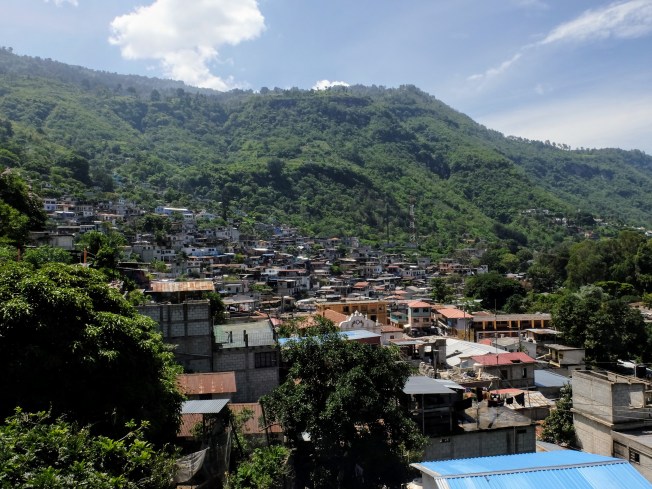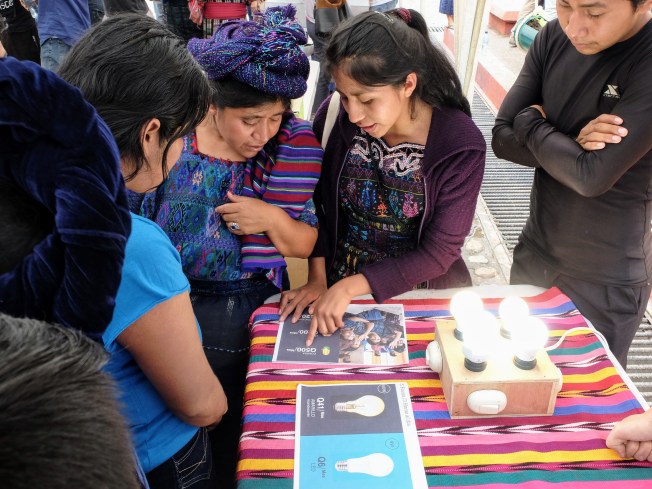
By Valeria Gaitan and Titiaan Palazzi
We spent the last three weeks in a small village on Lake Atitlán, one of the most beautiful lakes in the world. In addition to its natural beauty, the lake is a resource for surrounding villages. Unfortunately, population growth, modern innovations (such as motorized ships), and climate change are threatening the lake’s health.
Families around the lake face many challenges: lack of clean drinking water, high costs of wood and electricity, respiratory disease, and a local economy based almost entirely on tourism. These challenges are interconnected, so addressing them requires a systems perspective. How can we improve quality of life for people in such vulnerable conditions? How do we design for sustainability in such a complex system?
IDDS: summits to design for local development
We were in Guatemala exactly to answer these questions, by participating in an International Design for Development Summit (IDDS). IDDS summits are organized by MIT, IDIN and local professionals. For three weeks, we went through a design process to design and prototype solutions around the theme of sustainable homes. Our group included about 20 facilitators and 50 participants. Importantly, we were not working for the community but with the community; 16 of the 50 participants lived in Santa Catarina Palopó, a picturesque town of about 1,000 families where the summit took place.
The group was split into smaller teams, each addressing one specific subtopic of sustainable homes: energy, cooking methods, organic waste, plastic waste, food, water, sanitation, and construction methods.
Learning about people’s needs: Observe, Ask, and Experiment
Our team focused on energy. Our initial goal was to build relationships with the local community. To identify a specific problem, we had to learn about our users. To do so, we used a framework of Observe, Ask, and Experiment. We went from home to home, guided by our local team members, to interview people. We observed how people prepared their meals and washed their clothes. We spent hours in small kitchens learning to make tortillas and bathing in temazcals (a local form of sauna or sweat lodge used 2-3 times per week for bathing).
Energy influences every aspect of daily life

As we lived with local families, we realized that energy informs almost every element of daily life. The wood burnt in open fires or cook stoves causes respiratory diseases and eye problems. As villagers collect wood from surrounding hillsides, forests are decimated. This in turn can lead to destructive mudslides (a 2010 mudslide destroyed many of Santa Catarina Palopó’s homes). Families spend as much as half their income on energy; as a consequence, many families can’t keep their kids in school or visit a doctor.
This stands in stark contrast to the United States and Europe. Here, a shift to clean energy is critically important to prevent global climate change. But after switching a home in Copenhagen or Texas to solar PV, the people in it don’t perceive a difference in their daily lives.
Prototyping solutions to reduce the use of firewood and electricity
After our first week, we narrowed our focus to two problem areas: high consumption of firewood for heating the temazcals (used 2-3 times per week), and high electricity costs, largely as a consequence of incandescent lighting.
We then developed design requirements for each problem. Based on these design requirements, we brainstormed different types of solutions. During the final week, we focused on two efforts:
1. An effort to redesign burners in temazcals, with the key purpose to reduce wood consumption while improving the user experience (e.g., by reducing smoke inside the temazcal).
2. An effort to reduce electricity bills by changing incandescent bulbs to LEDs.

Most villagers heated their temazcal by building an open fire inside, on which they rested tiles and a pot of water. We built two wood burner prototypes applying the rocket stove design. We tested these prototypes with the families in Santa Catarina Palopó. Their feedback was positive: the prototypes reduced wood consumption from 10-15 logs to just 3-4 logs of firewood, while reducing smoke in the temazcal via a chimney. The prototypes are still in pilot phase at the homes, to analyze burner performance and user adoption.
To show the quality of LEDs, we developed a wooden box that fit an incandescent bulb, a fluorescent bulb, and two LEDs: one white, one yellow. We also developed marketing materials to explain the economic benefit of LEDs.
Reflecting on our experience, here are three key lessons about design for sustainability:
1. Design with the community, not for the community

At times, we were tempted to move ahead with a design without extensively consulting the local community. The organizers constantly reminded us to listen to the community and to engage them in the design process.
Although sometimes frustrating, we listened. The effort paid off.
First, by engaging local women in problem selection, we worked on problems that mattered to them. During a local workshop, we asked women what they found most frustrating in the experience of using the temazcal. We learned that the large volume of smoke was particularly challenging, especially for the women who were asked to start the fire inside the temazcal.
Second, by engaging our two team members from the community in every step of the process, we created advocates for our solutions. Days after we installed the first LEDs, Jessica and Lidia told many others about the opportunity to save electricity by switching lightbulbs. A message from them has an impact far greater than any message coming from people outside the community.
2. Local entrepreneurship can keep small communities alive

We asked several community members—most of whom were in their late twenties or early thirties—about their dreams. Many did not have full-time work. Most expressed a strong desire to find a well-paying job so they could support their families and create a better life.
Typically, jobs can only be found in larger towns and cities. If much of the younger generation leaves to find work elsewhere, this could mean the loss of many small towns and communities.
We learned that one path to create professional opportunities is through local entrepreneurship. What if young people can stay in their communities by creating new businesses?
This is exactly what both our initiatives are set up to do. Tech-savvy community members could manufacture the temazcal burners out of local materials and sell them to families in and around Santa Catarina Palopó. Well-connected local women can go door to door to inform people about the potential savings from LEDs, and then sell LEDs to families.
One of the most exciting moments was when Jessica, one of the two community members on our team, took us to several homes to inform people about LEDs. Typically shy, Jessica blew us away by giving a passionate, clear pitch at every home. Jessica showed herself to be a true advocate. She expressed a strong interest to build a local business to sell LEDs.
3. Business is a double-edged sword
New businesses can greatly improve quality of life. Cell phones allow people to be in touch with their families, avoiding many unnecessary trips. Better cookstoves reduce smoke, related health problems, wood burn, related energy costs and deforestation.
At the same time, big businesses have negative consequences. A national fried chicken chain, Pollo Campero, drives out many original, local restaurants. A national chicken vendor reduces the business opportunities for local villagers to grow and sell chickens. Toritos bags and Coca-Cola is sold in every small store and clearly leads to unhealthy diets.
The types of businesses that seem to add most value are those that provide high-quality products sold by local people.
Sustainability = Continuity
Of course, the work to date is just the beginning. Impact in the community requires sustained efforts. Fortunately, three of our team members live in Guatemala. They are already planning a next visit to the community, to ask about the two prototypes, and to organize a workshop for local people to build temazcal burners using locally available, reused, and low-cost materials.
We also seek to partner with a top-tier LED manufacturer to bring high-quality bulbs to the community, and to continue to train the local community members to become a door-to-door information and sales force.
Thank you to the Energy team who made all this possible: Maya Pérez, Lidia Cúmes, Jessica Pérez, Andrés Viau, Daniel Connell, and Amit Gandhi.
Thank you to the IDDS organizers María José Saenz, Sher Vogel, Omar Crespo, Oscar Quan, and Paul Crespo.




















